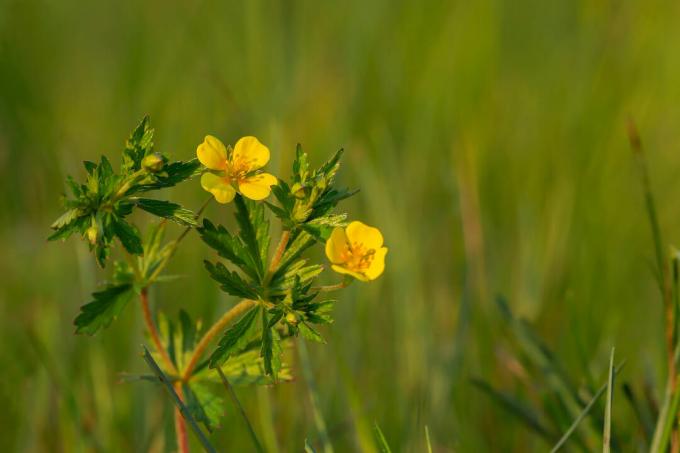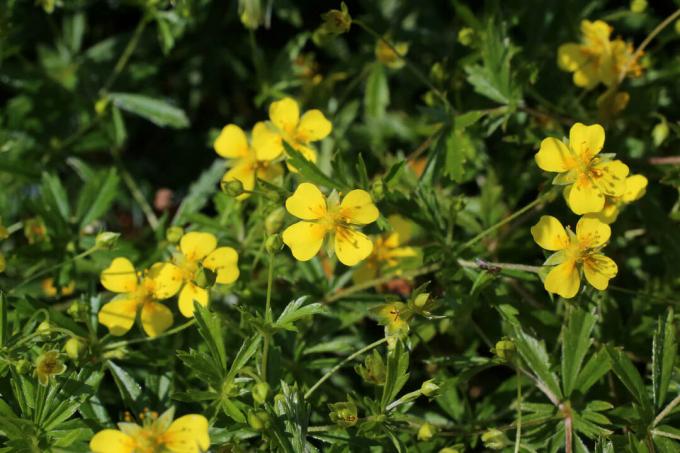As a domestic medicinal plant, tormentil is becoming increasingly popular in the garden. There the upright cinquefoil also makes the bees a pleasure.

The bloodroot (Potentilla erecta) not only looks beautiful, but also contains active ingredients of medicinal interest. In addition, it hardly needs any maintenance and multiplies in suitable locations in the garden as if by itself. We show what makes the plant and how to plant it.
contents
- Bloodroot: root, properties and origin
- Confusion with bloodroot: Similar plants
- Growing tormenti: location and procedure
- Proper care
- Harvest and use of tormentil
Bloodroot: root, properties and origin
The bloodroot (Potentilla erecta) belongs to the genus finger herbs (Potentilla) and is also called upright cinquefoil, tormentill or tormentilla, adder root, red root and seven-fingered. It occurs in temperate and boreal Europe, is native to Germany and is considered a pointer plant of nutrient-poor locations. The plant species from the rose family (Rosaceae) grows crawling on the ground, but also sends upright shoots upwards. The perennial, herbaceous plant reaches heights of up to 40 cm. The bloodroot got its name from its roots, which, strictly speaking, are rhizomes, i.e. thickened, subterranean shoots. These are thick and bulbous and show a blood red color when cut. The woody rhizome can be harvested in spring and has been used in healing since the Middle Ages. From May the bloodroot has flowering time. The yellow flowers sit individually on the stems and usually have four petals. The leaves sit directly on the stem and are in three parts. But since there are also stipules, as is usual for the rose family, they usually appear in five or more parts. The basal sheets, however, are petiolate.

Confusion with bloodroot: Similar plants
In general, there is a risk of confusion with bloodroot with other cinquefoil, such as creeping cinquefoil (Potentilla reptans), which, however, usually has five petals. Most species also bloom yellow and have similar, palm-shaped leaves to the upright cinquefoil. Some species of the buttercup family (Ranunculus), but they usually have more than four petals.

Growing tormenti: location and procedure
The erect cinquefoil can also be planted in the garden. As a native wild plant, insects like to visit it. A location in partial shade on poor soil with a rather acidic pH value is preferred for the tormentil. It can also handle sunnier places. The cold germs are best sown in early spring or in autumn at a distance of about 25 cm. You can also plant the tormentil in a pot. It is best to choose a deep vessel for the thick rhizome. Use a slightly acidic, nutrient-poor substrate such as ours for cultivation Plantura organic herb & seed compost. Our organic soil contains no peat and also contains fewer nutrients than potting soil, which benefits many kitchen and wild herbs and seedlings. If a little sand is mixed in, the young bloodroot will feel even better. The seeds should only be lightly covered with soil. For further cultivation in the pot and in the bed, you should then use a slightly more nutrient-rich soil, such as ours Plantura Bio-Acid Soil, use and mix this with 30% sand. It is ideally suited for the upright cinquefoil, as the plant needs an acidic environment and does not tolerate lime well. The acidic earth also provides you with all the important nutrients. It is advisable to place a drainage layer made of potsherds or stones under the substrate in the pot to allow the water to run off.
Proper care
Once in the garden, the bloodroot hardly needs any care. It is an extremely frugal plant species. It endures both sun and light shade, drought and nutrient shortages. If it doesn't rain for a long time in summer, you can water the tormentil a little. If you keep the cinquefoil in the pot, you should water a little more regularly, as the soil can dry out completely here faster.
As a rule, no fertilizer is required. Stands Potentilla erecta In the same location for a longer period of time, a single application of fertilizer in spring can support growth. For example our Plantura organic universal fertilizer which is suitable for most plants. All the important nutrients are gradually released here and made available to the plants. For the tormentil in the pot, it is sufficient to repot it in fresh soil every two to three years. No maintenance measures are necessary in winter as the tormentil is hardy. The upper parts of the plant die in the cold season, but the roots survive in the ground and the cinquefoil will sprout again in the next spring.

Harvest and use of tormentil
In the first year the root of the tormentil should not be harvested, from the second year onwards the harvest can take place in October or November. To do this, the plant is dug up and part of the rhizome is cut off. This is freed from the roots that emerge from it. The tormentil can then simply be replanted with the rest of the rhizome. The rhizome can then be cleaned, chopped up and dried for two to three weeks.
The tannins contained in the rhizome can relieve itching or stop bleeding on the skin. Consumption can also help against gastrointestinal complaints. In addition, bloodroot tinctures can be gargle and are said to have an anti-inflammatory effect. A bloodroot tea is also said to have healing effects. For the correct dosage, you should definitely seek advice from a doctor or a pharmacy.

A bloodroot schnapps or bloodroot liqueur is also often prepared from the plant.
Also the Comfrey is an uncomplicated wild plant with healing properties. We show you how to plant and care for it in the garden.



